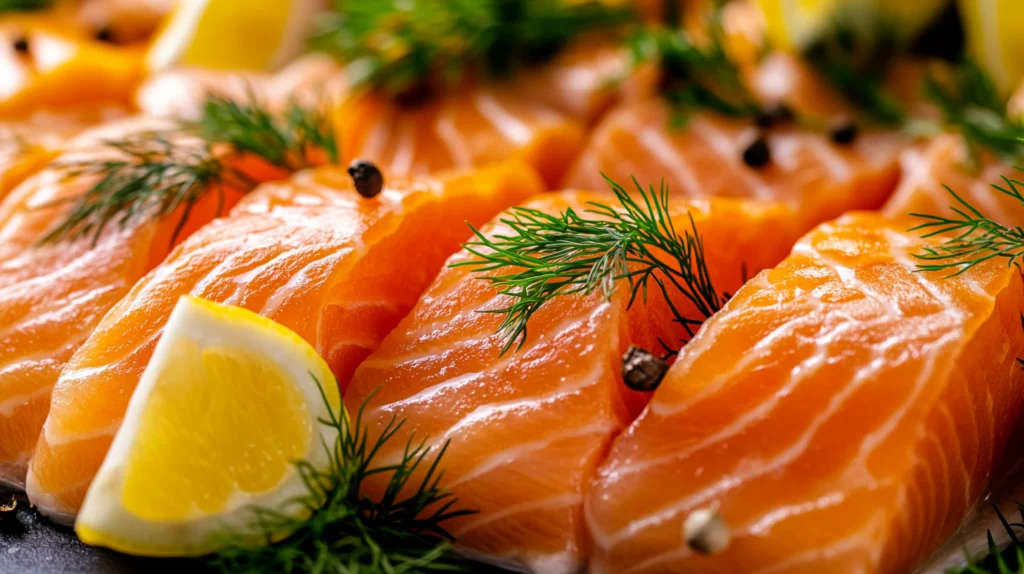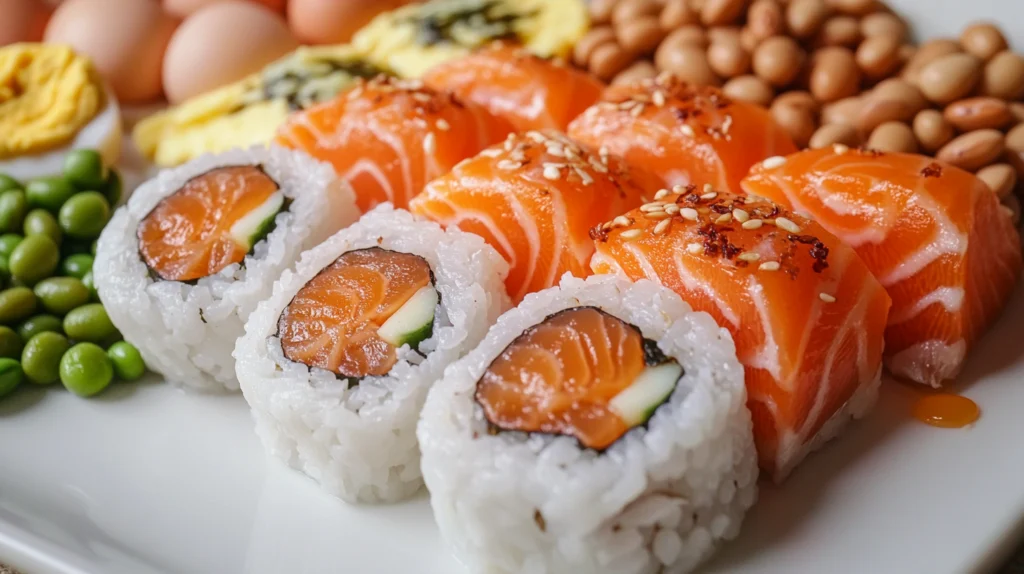If you’ve ever wondered, is salmon cucumber roll healthy, the answer largely depends on the ingredients it contains. The core components—salmon, cucumber, rice, and nori—each bring their own nutritional benefits to the table. Moreover, the simplicity of this dish ensures that it delivers plenty of flavor without unnecessary additives.
Understanding the Ingredients
1. Overview of Salmon
Salmon is a superstar in the world of nutrition. Packed with omega-3 fatty acids, it supports brain health, reduces inflammation, and protects heart health. A typical salmon cucumber roll contains raw or lightly cooked salmon, which preserves these fatty acids.
Link to King Salmon Recipe when discussing the nutritional benefits of salmon.
Salmon is the highlight of this dish. Rich in omega-3 fatty acids, it supports heart and brain health while reducing inflammation. For those asking, is salmon cucumber roll healthy, the answer is a resounding “yes” thanks to salmon’s high protein content and abundance of vitamins like D and B12. These nutrients help build strong bones, boost immunity, and support overall health.
This rich nutritional profile makes salmon a key reason why salmon cucumber rolls are often recommended as a healthy meal.

2. The Role of Cucumber
Cucumber is a low-calorie vegetable that keeps the roll light and refreshing. Its water content, which makes up 95% of its weight, aids hydration and weight management. This is another reason why many ask, is salmon cucumber roll healthy, as cucumber adds volume without significantly increasing calories.
Use Smoked Salmon Rolls on Cucumber as an anchor for exploring alternative preparation styles.
Cucumber also contains antioxidants, such as beta-carotene and flavonoids, which help combat oxidative stress in the body.
3. Rice and Seaweed in Sushi Rolls
The sushi rice provides energy through its carbohydrate content, while nori (seaweed) offers iodine, which supports thyroid health. Together, these components make salmon cucumber rolls a balanced and nutritious meal. For those wondering, is salmon cucumber roll healthy, the seaweed’s contribution of vitamins A and C further bolsters its status as a health-conscious option.
Health Benefits of Salmon Cucumber Rolls
4. Rich in Omega-3 Fatty Acids
Salmon is one of the best sources of these healthy fats, particularly EPA (eicosapentaenoic acid) and DHA (docosahexaenoic acid). These compounds are known for their ability to lower triglycerides, reduce blood pressure, and improve overall cardiovascular health.
Moreover, omega-3s play a significant role in brain function, helping to enhance memory and mood. Including salmon cucumber rolls in your diet can be an easy way to meet your weekly omega-3 requirements.
5. High Protein Content
Protein is an essential nutrient for maintaining and building muscle, regulating enzymes and hormones, and boosting overall health. Salmon cucumber rolls deliver a high-quality source of protein from the salmon itself. Protein also has a satiating effect, which means it helps you feel full for longer and prevents overeating. This makes salmon cucumber rolls a smart choice for those managing their weight.

6. Low-Calorie Option
If you’re still asking, is salmon cucumber roll healthy, consider its numerous health benefits. First, salmon’s omega-3 fatty acids help reduce the risk of heart disease and improve cognitive function. Second, the protein in salmon promotes muscle repair and keeps you full longer, making these rolls a smart choice for weight management. Finally, the low-calorie nature of cucumber ensures you can enjoy this dish guilt-free.
Potential Health Concerns
Although the answer to is salmon cucumber roll healthy is mostly positive, there are a few considerations to keep in mind. High sodium levels from soy sauce can detract from the roll’s healthiness, and the carbohydrate content of sushi rice may not suit everyone, especially those with specific dietary restrictions. However, by choosing low-sodium alternatives and moderating portion sizes, you can easily overcome these challenges.
Anchor The Secret to the Best Salmon to guide readers interested in perfecting salmon recipes.
7. Sodium Content
One of the biggest health considerations with sushi is sodium. Soy sauce, a common condiment served with sushi, contains high levels of sodium, which can lead to water retention and increased blood pressure in individuals sensitive to salt. Even low-sodium soy sauce, though a better alternative, still contributes to daily sodium intake.
Additionally, sushi rice is often seasoned with a mixture of vinegar, sugar, and salt to enhance flavor and texture. This can add to the sodium content of the roll itself.
To manage sodium intake:
- Use low-sodium soy sauce sparingly.
- Avoid dipping the roll entirely into soy sauce; instead, brush a small amount onto the roll for flavor.
8. Mercury in Salmon
Although salmon is generally considered a low-mercury fish compared to larger species like tuna or swordfish, consuming it in excess may still lead to mercury exposure. Mercury is a toxic metal that can accumulate in the body over time, potentially leading to neurological issues.
To minimize risks:
- Choose wild-caught salmon when possible, as it tends to have lower mercury levels than farmed salmon.
- Limit sushi consumption to two or three servings per week, especially if you’re pregnant or breastfeeding.
9. Carb Content in Rice
While sushi rice is a staple of sushi rolls, it is also a refined carbohydrate, meaning it is quickly broken down into sugar in the body. This can lead to spikes in blood sugar levels, which may not be ideal for individuals with diabetes or those monitoring their carbohydrate intake.
If you are concerned about the carbohydrate content:
- Opt for rolls made with less rice or try sashimi, which skips the rice altogether.
- Pair your meal with a side of fiber-rich vegetables to slow the absorption of carbohydrates.
Ways to Maximize Health Benefits
10. Choosing Low-Sodium Options
Reducing sodium intake is one of the easiest ways to make salmon cucumber rolls even healthier. Look for low-sodium soy sauce options or skip the soy sauce entirely in favor of other seasonings like lemon juice or wasabi.
Add Grilled Sockeye Salmon Recipe for additional cooking inspiration.
Another way to control sodium is to make the rolls at home. This allows you to adjust the seasoning of the rice and avoid added salt entirely.
11. Adding Nutrient-Rich Ingredients
While salmon and cucumber are nutritious, you can enhance the health benefits of your roll by adding other nutrient-dense ingredients:
- Avocado: A great source of healthy fats that support heart health.
- Pickled Ginger: A natural palate cleanser that also contains antioxidants and aids digestion.
- Sesame Seeds: Rich in healthy fats, fiber, and trace minerals like zinc and magnesium.
These additions not only boost the roll’s nutritional profile but also add variety and flavor.
12. Ensuring Freshness
When it comes to sushi, freshness is critical to avoid foodborne illnesses. Raw fish, like salmon, must be handled and stored properly to prevent contamination. If you’re making sushi at home, ensure the fish is sushi-grade, which means it has been frozen and handled to kill parasites.
If dining out, choose reputable restaurants with good reviews and visible cleanliness standards. Avoid eating raw sushi rolls if you are immunocompromised or pregnant, as these groups are more susceptible to foodborne illnesses.
FAQs About Salmon Cucumber Rolls
To help you make the most of your sushi experience, here are some frequently asked questions about salmon cucumber rolls and their health implications.
1.Are Salmon Cucumber Rolls Suitable for Weight Loss?
Yes, salmon cucumber rolls can be an excellent choice for weight loss. They are low in calories compared to many other sushi rolls, especially those containing cream cheese, tempura, or mayonnaise-based sauces. The cucumber adds volume and crunch without significantly increasing calorie content, while the salmon provides satiating protein and healthy fats.
For a weight-loss-friendly meal:
- Pair salmon cucumber rolls with a side salad or steamed edamame for extra fiber and nutrients.
- Avoid high-calorie condiments like spicy mayo or sweet eel sauce.
2.Can Salmon Cucumber Rolls Be Made Gluten-Free?
Yes, salmon cucumber rolls can easily be made gluten-free. While traditional soy sauce contains gluten, you can use tamari or gluten-free soy sauce as a substitute. Additionally, ensure the sushi rice seasoning does not contain malt vinegar, which may have traces of gluten.
If dining out, let the restaurant staff know about your dietary requirements. Many sushi restaurants offer gluten-free options, but it’s important to confirm that no cross-contamination occurs during preparation.
3.How Many Salmon Cucumber Rolls Should You Eat?
Portion control depends on your nutritional goals and overall calorie intake for the day. A standard serving of sushi is about six to eight pieces, which provides a balanced meal with protein, carbohydrates, and healthy fats.
For a lighter meal, three to four pieces can be paired with a side dish like miso soup or a small serving of sashimi. For a more filling meal, opt for a full roll but balance it with vegetables or low-calorie side dishes.
4.Are Salmon Cucumber Rolls Safe During Pregnancy?
Salmon cucumber rolls can be safe during pregnancy if made with fully cooked salmon instead of raw. Pregnant individuals are advised to avoid raw fish to minimize the risk of foodborne illnesses like listeria or parasites. Opt for rolls made with cooked salmon or other pregnancy-safe proteins like tofu or shrimp.
If you’re dining out, confirm with the restaurant that the fish used in your rolls is cooked and prepared in a sanitary environment.
5.Do Salmon Cucumber Rolls Contain Any Allergens?
Yes, salmon cucumber rolls can contain allergens. The most common allergens in these rolls include:
- Fish (salmon): Individuals with a fish allergy should avoid this roll entirely.
- Soy (from soy sauce): If you have a soy allergy, skip the soy sauce or replace it with a safe alternative.
- Sesame (if sesame seeds are added): Be sure to confirm whether sesame seeds are used as a garnish.
When dining out, inform the restaurant of any allergies to ensure your meal is prepared safely.
6.Can I Make Salmon Cucumber Rolls at Home?
Absolutely! Making salmon cucumber rolls at home allows you to control the ingredients, portion sizes, and seasoning, making it a healthier and more customizable option. You’ll need sushi-grade salmon, nori sheets, sushi rice, cucumber, and a bamboo mat for rolling.
Homemade rolls are not only cost-effective but also a fun and interactive way to enjoy sushi with family or friends.
Is a Salmon Cucumber Roll the Right Choice for You?
Salmon cucumber rolls provide a nutritious and flavorful option for sushi lovers. Their combination of protein, healthy fats, and low-calorie vegetables makes them a balanced and health-conscious choice. However, like any meal, they work best when integrated into a varied diet that considers both their advantages and possible concerns.
Why Choose Salmon Cucumber Rolls?
These rolls offer simplicity and a wealth of health benefits. First of all, they are a perfect combination of taste and nutrition. In addition, they are versatile and cater to various dietary preferences. Here are a few specific reasons why you might choose salmon cucumber rolls:
- Nutritious Ingredients: Salmon supplies essential omega-3 fatty acids and high-quality protein, while cucumber adds hydration and crunch without significantly increasing calories.
- Low-Calorie Meal: Compared to options like tempura or rolls with creamy sauces, salmon cucumber rolls are a lighter and healthier alternative.
- Customizable Choices: You can adjust the ingredients to match dietary preferences by including nutrient-dense toppings or selecting gluten-free and low-sodium options.
In summary, these rolls offer a harmonious blend of flavor, versatility, and nutrition.
Tips for Maximizing Health Benefits
To fully enjoy salmon cucumber rolls while boosting their health benefits, there are several easy strategies you can follow. By doing so, you ensure that this already nutritious dish becomes an even better option for your dietary needs.
- Reduce Sodium: Opt for low-sodium soy sauce or season your rolls with alternatives like lemon juice or wasabi to minimize salt consumption. Additionally, making your soy sauce at home allows you to control the sodium levels further.
- Control Portions: Stick to one or two rolls per meal to prevent excessive intake of carbohydrates from the rice. At the same time, you can balance your meal by pairing the rolls with fiber-rich vegetables or a side of miso soup.
- Use Fresh Ingredients: Whether you are preparing rolls at home or ordering them at a restaurant, always select high-quality, fresh ingredients. After all, freshness enhances flavor and ensures safety by reducing the risk of foodborne illnesses.
Overall, by making these adjustments, you can enhance the health benefits of salmon cucumber rolls without sacrificing taste or enjoyment.
Conclusion
Salmon cucumber rolls offer a delightful way to enjoy sushi while benefiting from their exceptional nutritional profile. These rolls combine the richness of omega-3 fatty acids, the protein content of salmon, and the refreshing crunch of cucumber into one satisfying dish. Furthermore, a few thoughtful adjustments—such as moderating sodium intake and ensuring freshness—can make them a perfect fit for a wide variety of dietary goals.
So, the next time you’re in the mood for sushi, consider salmon cucumber rolls as a delicious, healthful option. In the end, finding a meal that’s both enjoyable and nutritious is always a win!
Include Copper River Salmon Recipe for those curious about premium salmon varieties.

